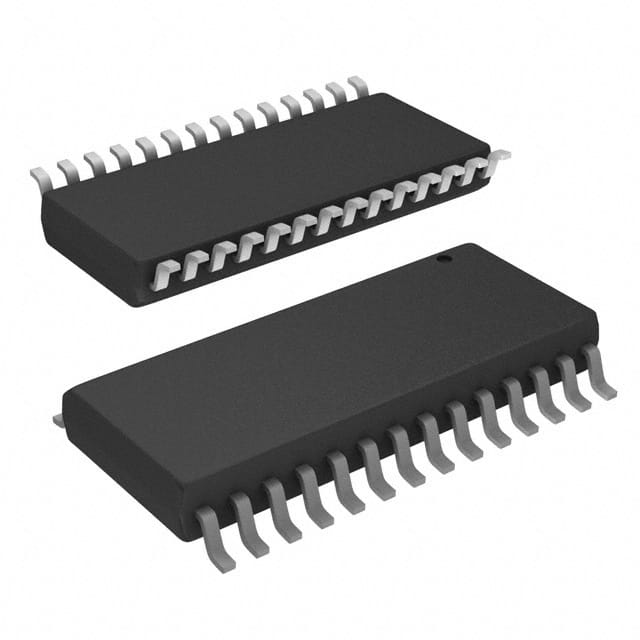Viz Specifikace pro podrobnosti o produktu.

PIC16LF1518-I/SO
Product Overview
Category
The PIC16LF1518-I/SO belongs to the category of microcontrollers.
Use
This microcontroller is commonly used in various electronic devices and embedded systems for controlling and processing data.
Characteristics
- Low power consumption
- High performance
- Small form factor
- Wide operating voltage range
- Enhanced peripheral integration
Package
The PIC16LF1518-I/SO is available in a small outline (SO) package.
Essence
The essence of this microcontroller lies in its ability to provide efficient control and processing capabilities in a compact and low-power package.
Packaging/Quantity
The PIC16LF1518-I/SO is typically packaged in reels or tubes, with a quantity of 2500 units per reel/tube.
Specifications
- Microcontroller family: PIC16
- Core architecture: 8-bit
- CPU speed: Up to 32 MHz
- Program memory size: 14 KB
- RAM size: 512 bytes
- Number of I/O pins: 20
- ADC channels: 10-bit, 12 channels
- Communication interfaces: UART, SPI, I2C
- Operating voltage range: 1.8V to 5.5V
- Operating temperature range: -40°C to +125°C
Detailed Pin Configuration
The PIC16LF1518-I/SO microcontroller has a total of 20 pins. The pin configuration is as follows:
- VDD - Power supply voltage
- RA0 - General-purpose I/O pin
- RA1 - General-purpose I/O pin
- RA2 - General-purpose I/O pin
- RA3 - General-purpose I/O pin
- RA4 - General-purpose I/O pin
- RA5 - General-purpose I/O pin
- VSS - Ground
- RB0 - General-purpose I/O pin
- RB1 - General-purpose I/O pin
- RB2 - General-purpose I/O pin
- RB3 - General-purpose I/O pin
- RB4 - General-purpose I/O pin
- RB5 - General-purpose I/O pin
- RB6 - General-purpose I/O pin
- RB7 - General-purpose I/O pin
- RC0 - General-purpose I/O pin
- RC1 - General-purpose I/O pin
- RC2 - General-purpose I/O pin
- RC3 - General-purpose I/O pin
Functional Features
- Enhanced core with 49 instructions
- Integrated peripherals for various applications
- Low-power sleep mode for power conservation
- Timer modules for precise timing operations
- Analog-to-digital converter (ADC) for analog signal processing
- Serial communication interfaces for data exchange
- Interrupt capability for event-driven programming
Advantages and Disadvantages
Advantages
- Low power consumption enables energy-efficient designs
- High-performance core allows for fast and efficient processing
- Small form factor saves space in compact electronic devices
- Wide operating voltage range provides flexibility in power supply options
- Enhanced peripheral integration simplifies system design
Disadvantages
- Limited program memory size may restrict the complexity of applications
- Limited RAM size may impose constraints on data storage and manipulation
- Limited number of I/O pins may limit the connectivity options
- Lack of advanced features found in higher-end microcontrollers
Working Principles
The PIC16LF1518-I/SO microcontroller operates based on the Von Neumann architecture, where program instructions and data are stored in the same memory space. It executes instructions sequentially, fetching them from program memory and performing the necessary operations.
The microcontroller interacts with external devices through its I/O pins, which can be configured as inputs or outputs. It communicates with other devices using various communication interfaces such as UART, SPI, and I2C.
Detailed Application Field Plans
The PIC16LF1518-I/SO microcontroller finds applications in a wide range of fields, including but not limited to:
- Home automation systems
- Industrial control systems
- Automotive electronics
- Medical devices
- Consumer electronics
- Internet of Things (IoT) devices
- Robotics
- Security systems
- Energy management systems
- Sensor networks
Detailed and Complete Alternative Models
- PIC16LF1519-I/SO
- PIC16LF1526-I/SO
- PIC16LF1527-I/SO
- PIC16LF1528-I/SO
- PIC16LF1529-I/SO
- PIC16LF15313-I/SO
- PIC16LF15323-I/SO
- PIC16LF15324-I/SO
- PIC16LF15325-I/SO
- PIC16LF15326-I/S
Seznam 10 běžných otázek a odpovědí souvisejících s aplikací PIC16LF1518-I/SO v technických řešeních
What is the operating voltage range of PIC16LF1518-I/SO?
- The operating voltage range of PIC16LF1518-I/SO is 1.8V to 3.6V.Can PIC16LF1518-I/SO be used in battery-powered applications?
- Yes, PIC16LF1518-I/SO is suitable for battery-powered applications due to its low power consumption.What are the key features of PIC16LF1518-I/SO?
- Some key features of PIC16LF1518-I/SO include a wide operating voltage range, low power consumption, and multiple communication interfaces.Is PIC16LF1518-I/SO suitable for temperature-sensitive applications?
- Yes, PIC16LF1518-I/SO has a wide operating temperature range and can be used in temperature-sensitive applications.Can PIC16LF1518-I/SO be programmed using standard development tools?
- Yes, PIC16LF1518-I/SO can be programmed using Microchip's MPLAB® X IDE and other standard development tools.What communication interfaces are supported by PIC16LF1518-I/SO?
- PIC16LF1518-I/SO supports SPI, I2C, and UART communication interfaces.Does PIC16LF1518-I/SO have built-in analog-to-digital converters (ADC)?
- Yes, PIC16LF1518-I/SO has a 10-bit ADC with multiple channels.What is the maximum clock frequency supported by PIC16LF1518-I/SO?
- PIC16LF1518-I/SO supports a maximum clock frequency of 32 MHz.Can PIC16LF1518-I/SO be used in industrial control applications?
- Yes, PIC16LF1518-I/SO is suitable for industrial control applications due to its robust design and communication capabilities.Are there any specific development boards available for PIC16LF1518-I/SO?
- Yes, there are development boards specifically designed for PIC16LF1518-I/SO, such as the Curiosity Development Board.

